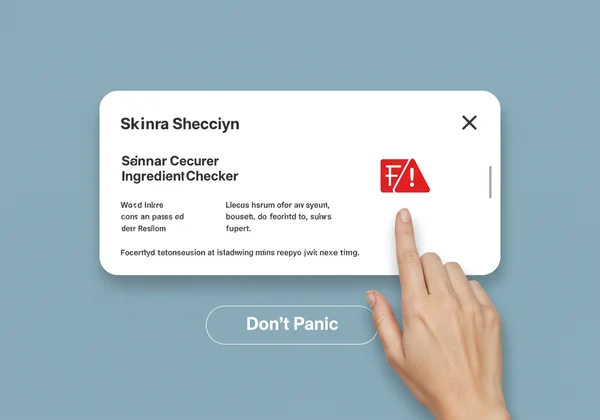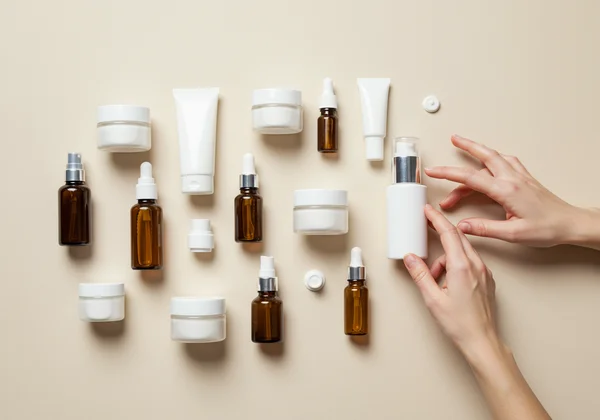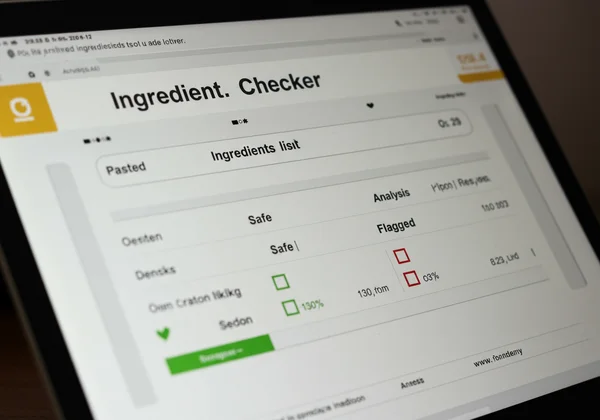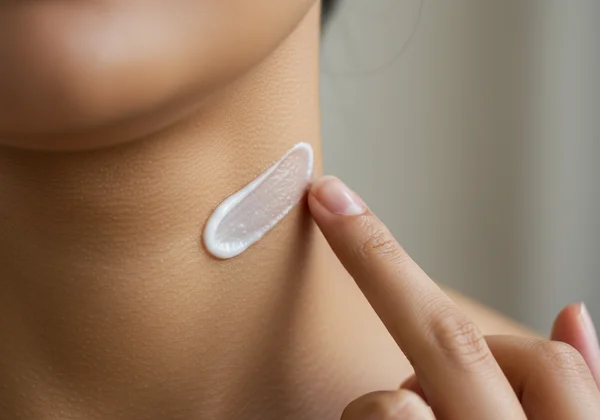Found a Pore-Clogging Ingredient? Your Skincare Action Plan
That sinking feeling is all too familiar. You’ve just used a pore clogging ingredient checker, and your favorite, most trusted product has been flagged. A red alert flashes next to an ingredient you can't even pronounce. Don't panic! This moment isn't a setback; it's a breakthrough. Discovering a potential culprit is the first, most crucial step toward taking control of your skin's health. But the big question is, what to do after using a pore clogging checker?
This guide is your clear, actionable plan. We understand the frustration of trying countless products only to face more breakouts. Here, we'll walk you through a simple, step-by-step process to intelligently phase out problematic products, find trustworthy alternatives, and build a routine that truly works for you. Your journey to clearer skin is just beginning, and you can start it with confidence. Ready to make a change? You can always check your products on our homepage.
What to Do After Identifying a Pore-Clogging Ingredient?
Seeing a red flag on your analysis is a pivotal moment. It’s easy to feel betrayed by a product you loved, but your reaction now will determine your future skin success. Let's navigate these initial steps with a calm and logical approach.
Don't Panic: Interpreting Ingredient Checker Results
First, take a deep breath. A single flagged ingredient doesn't automatically mean you have to toss the product in the trash immediately. The results from a pore clogging checker are your roadmap, not a final judgment. It's essential to understand the context.
Comedogenicity—the likelihood of an ingredient to clog pores—is often rated on a scale (typically 0 to 5), a concept first detailed in foundational dermatological research (source: National Library of Medicine). An ingredient with a high rating is more likely to cause issues for acne-prone skin. However, its concentration in the product matters. If the problematic ingredient is listed near the end of the ingredients list, it's present in a very small amount and may not be affecting you. Conversely, if it's one of the first five ingredients, its impact is much more significant. Your skin's unique sensitivity also plays a massive role; what clogs one person's pores might be perfectly fine for another.

Confirming the Culprit: Identifying Acne Triggers
Before making any drastic changes, play detective. Is this single ingredient truly the source of your breakouts? Acne is complex and can be influenced by hormones, diet, stress, and other lifestyle factors. If you suspect a product, the best way to confirm is through product elimination.
Try removing only that specific product from your routine for 2-4 weeks. Continue using everything else as normal. If your skin begins to clear up, you've likely found your trigger. If nothing changes, the issue might lie with another product or factor. This methodical approach prevents you from mistakenly blaming a harmless product while the real culprit remains hidden in your routine.

Finding Alternatives: Your Guide to Non-Comedogenic Products
Once you've confirmed that a product is causing issues, the next step is finding a safe replacement. This is where you can truly empower yourself by making informed choices, moving from a reactive to a proactive skincare strategy. This is where our acne safe product checker becomes an essential tool.
Decoding 'Non-Comedogenic': What Labels Mean
You've seen the labels everywhere: "non-comedogenic," "oil-free," "won't clog pores." While these sound reassuring, it's important to know that these terms are not strictly regulated by the FDA (source: FDA Cosmetics Labeling Guide). A brand can perform its own internal testing (or none at all) and still use this label. Many products labeled "non-comedogenic" still contain ingredients known to be moderately pore-clogging.
This is why relying on marketing claims is risky. The only way to be sure is to analyze the full ingredient list. Your best defense is knowledge and an unbiased tool that can help you see past the marketing hype and focus on the actual formulation of the product.
Key Ingredients to Look For in an Acne-Safe Ingredients List
When searching for new products, instead of just avoiding the bad, start looking for the good. Build an acne-safe ingredients list of things that can actively benefit your skin. Look for formulations that include:
- Salicylic Acid (BHA): Exfoliates inside the pores to clear out oil and dead skin cells, a benefit highlighted by the American Academy of Dermatology.
- Niacinamide (Vitamin B3): Helps regulate oil production, reduces inflammation, and improves skin barrier function, with its effects on skin health being well-documented in dermatological studies.
- Squalane: A lightweight, non-comedogenic oil that provides hydration without feeling greasy.
- Hyaluronic Acid: Attracts moisture to the skin, keeping it hydrated and balanced.
- Green Tea Extract: A powerful antioxidant with anti-inflammatory properties.
Focusing on products that contain these beneficial ingredients can help support your skin's health while you avoid known triggers.
How to Use Our Tool for New Products
This is where you change the game. Instead of buying a product and hoping for the best, vet it before you purchase. When you're in a store or browsing online, copy the full ingredient list of a potential new product. Paste it directly into our comedogenic ingredient checker on the homepage.

In seconds, you’ll get an unbiased, data-driven analysis. This simple, two-minute check can save you weeks of potential breakouts and wasted money. Make it a non-negotiable step in your shopping process to build a routine composed entirely of products you can trust.
How to Replace Skincare Products Safely
Now that you have a potential replacement product that has passed the ingredient check, it's crucial to introduce it correctly. Abruptly changing your routine can shock your skin and cause irritation, making it difficult to tell if the new product is working.
The Gradual Approach: How to Transition Skincare Products
The golden rule is to introduce only one new product at a time. If you swap out your cleanser, moisturizer, and serum all at once, and then break out, you'll have no idea which product is the cause.
Start by replacing just one item—the one you've identified as the most likely culprit. Use the new product exclusively for at least two weeks before considering another change. This slow, steady approach allows your skin to acclimate and gives you clear feedback on how the new product is performing. Patience is key to long-term skin health.
Patch Testing: Your Skin's Best Friend
Before applying a new product all over your face, always perform a patch test for new skincare. This simple step helps you check for allergic reactions or immediate irritation.
Apply a small amount of the new product to a discreet area of skin, like behind your ear or on your jawline. Do this once a day for three to five days. If you experience any redness, itching, burning, or breakouts in that specific spot, the product is not a good fit for you. If the area remains clear and calm, you can proceed with applying it to your face.

Monitoring Your Skin's Response: Skincare Purging vs Breakout
When introducing products with active ingredients (like salicylic acid), you might experience something called "purging." This is a temporary increase in breakouts in areas where you normally get them. It happens because the active ingredient is accelerating skin cell turnover, pushing existing clogs to the surface faster. Purging typically resolves within a few weeks.
In contrast, a breakout from a negative reaction often involves pimples appearing in new areas where you don't typically break out. These might also be accompanied by itching or redness. Understanding the difference between skincare purging vs breakout can help you decide whether to stick with a new product or stop using it.
Your Journey to Clearer Skin Starts Now
Discovering a pore-clogging ingredient in your routine is not a failure—it's an opportunity. It's the moment you stop guessing and start analyzing. By using a systematic approach—confirming the culprit, finding safe alternatives with a reliable tool, and introducing new products carefully—you are taking back control.
You now have the knowledge and the action plan to build a skincare routine that is truly customized for your skin's needs. Empower yourself with information and make every product choice a confident one. Your path to healthier, clearer skin starts with your next ingredient check. Are you ready to analyze your routine? Try our free tool today and unveil the truth.
Your Questions Answered
How do I know if a specific ingredient is truly the cause of my acne?
The most reliable way is the process of elimination. Remove the product containing the suspected ingredient from your routine for 2-4 weeks. If your acne improves, that product was likely a contributor. Since many factors cause acne, this method helps isolate skincare-related triggers.
Can non-comedogenic products still cause breakouts?
Yes, absolutely. The term "non-comedogenic" is not regulated, so it's more of a marketing claim than a scientific guarantee. Furthermore, skin is highly individual. An ingredient that is fine for 99% of people might still cause a reaction for you. That's why checking the full ingredient list with an unbiased pore clog checker is always more reliable than trusting a label.
What is the best way to introduce new, acne-safe products into my routine?
The best method is to go slow. Introduce only one new product at a time and use it for at least two weeks before adding anything else. Always perform a patch test on a small area of skin for a few days first to check for any immediate negative reactions before applying it to your entire face.
How often should I use the PoreCloggingChecker tool?
Use it every time you consider buying a new skincare, makeup, or hair care product. Make it a habit to check ingredients before you purchase to prevent potential breakouts. It’s also a great idea to periodically re-check your existing products, as you might have missed something, or your skin's needs may have changed.
What ingredients should I avoid for acne-prone skin?
The list of potentially pore-clogging ingredients is extensive and includes certain oils (like Coconut Oil and Cocoa Butter), fatty acids (like Isopropyl Myristate), and even some "natural" ingredients. Because memorizing them all is nearly impossible, the most effective strategy is to use a reliable acne ingredient checker to do the hard work for you.
Disclaimer: This article is for informational purposes only and does not constitute medical advice. The information provided by PoreCloggingChecker is intended to be a helpful resource, but it should not replace consultation with a qualified dermatologist or medical professional.